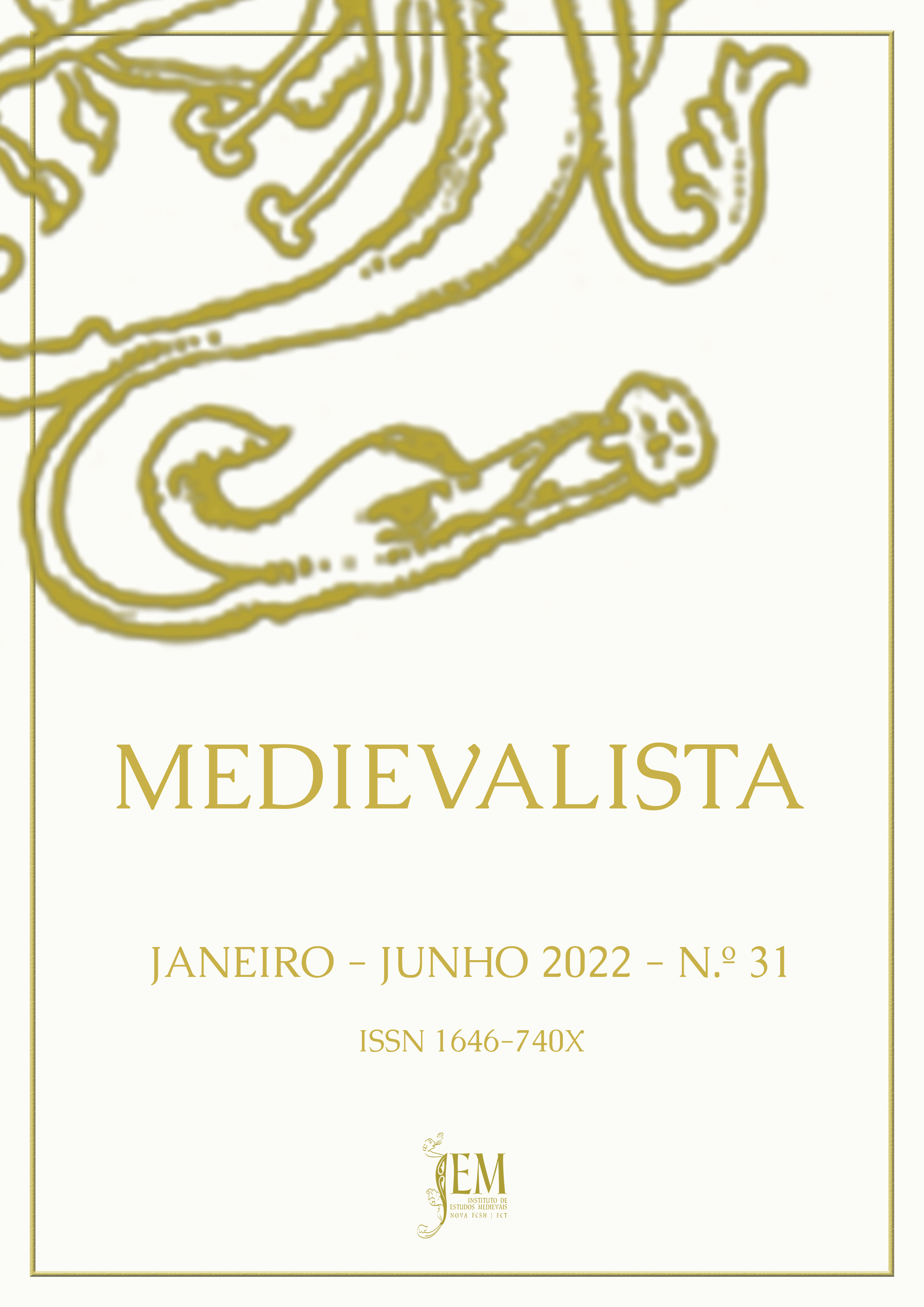El golpe de Estado de Focas (602): ¿un levantamiento social?
DOI:
https://doi.org/10.4000/medievalista.5129Palabras clave:
Bizancio. Siglo VII. Focas. Crisis social. Golpe de Estado.Resumen
Partiendo de una reevaluación de las fuentes disponibles, se propone una revisión de uno de los momentos clave en el devenir histórico del Imperio romano de Oriente, el golpe de Estado que llevó al poder a Focas en 602. Fue el primer hecho de este tipo que se dio en Constantinopla, creando una situación de inestabilidad que marcaría todo el siglo VII. Este estudio pone el acento en el contexto social y económico en el que se produjo, enclavándolo en las tensiones existentes entre el estamento aristocrático y el resto de la población romana. La extrema crueldad con la que se produjo la deposición de Mauricio, y que también afectó a su familia, sería la prueba de que se trató de una venganza social.
Referencias bibliograficas
Fuentes impresas
AGAPIOS – Kitab al-‘Unvan. Ed. y trad. A. Vasiliev, Histoire universelle écrite par Agapius (Mahboub) de Menbidj. Second Partie. Turnhout: Brepols, 1971.
AGNELLUS – Liber Pontificalis Ecclesiae Ravennatis. Trad. D. Mauskopf Deliyannis. Washington: The Catholic University of America Press, 2004.
Chronicon Paschale. Ed. L. Dindorff, Bonn: Weber, 1832. Trad. M. Whitby y M. Whitby, Liverpool: Liverpool University Press, 19972.
GEORGES CEDRENOS – Synopsis Historion. Ed. I. Bekker, 2 vols. Bonn: Weber, 1838.
GEORGES PISIDIAS – Heraclias. Editado y traducido in Espejo Jaiméz, Gonzalo – Significación literaria e ideológica en la tradición bizantina de los Panegíricos Épicos de Jorge de Pisidia. Granada: Universidad de Granada, 2015. Tesis doctoral.
JUAN DE ANTIOQUÍA – Ed. C. Müller. Fragmenta Historicorum Græcorum. Vol. V. Paris: Ambrosio Firmin Didot, 1873.
JUAN DE NIKIU – Chronique. Ed. y trad. H. Zotenberg in Chronique de Jean, évêque de Nikiou. Texte éthiopien publié et traduit. Paris: Imprimerie Nationale, 1883. Trad. R. H. Charles, The Chronicle of John, Bishop of Nikiu: Translated from Zotenberg´s ethiopic text. London: Text and Translation Society, 1916.
MAURICIO – Strategikon. Ed. y trad. G. T. Dennis; E. Gamillscheg. Viena: Österrei-chischen Akademie der Wissenschaften, 1981. Trad. española E. Magaña Orúe; J. Rodríguez González; J. I. de la Torre Rodríguez. Madrid: Ministerio de Defensa, 2014.
MIGUEL EL SIRIO – Chronique du Michel le Syrien Patriarche Jacobite d’Antioche. Trad. J.-B. Chabot. 3 vols. Bruxelles: Culture et Civilisation, 1963.
PAULUS DIACONUS – Historia gentis Langobardorum. Trad. P. Herrera Roldán. Cádiz: Servicio de Publicaciones de la Universidad de Cádiz, 2006.
PROCOPIO DE CESAREA – Historia Arcana. Trad. J. Signes Codoñer, Madrid: Gredos, 2000.
“The Secular History of Dionysius of Tel-Maḥrē”. In The Seventh Century in the West-Syrian Chronicles. Trans. Andrew Palmer. Liverpool: Liverpool University Press, 1993.
THEOPHANES – Chronographia. Ed. C. De Boor. Trad. C. Mango y R. Scott. Leipzig: Teubner, 1883, Oxford: Clarendon Press, 1997.
THEOPHYLACTO SIMOCATTA – Historia. Ed. C. De Boor. Leipzig: Teubner, 1887. Trad. M. Whitby y M. Whitby. Oxford: Oxford University Press, 1986.
Estudios
AHRWEILER, Hélène – L'idéologie politique de l'Empire byzantin. Paris: Presses Universitaires de France, 1975.
BÜNTGEN, Ulf; et al. – “Cooling and societal change during the Late Antique Little Ice Age from 536 to around 660 AD”. Nature Geoscience 9 (2016), pp. 231-237.
BURY, John B. – A History of the Later Roman Empire from Arcadius to Irene (395 A.D.-800 A.D.). 2 vol. London-New York: MacMillan, 1889.
GIBBON, Edward – Historia de la Decadencia y Caída del Imperio Romano. Trad. J. Mor Fuentes. Edición, revisión y actualización de L. A. Romero, 4 tomos. Madrid: Turner, 2006.
GRANINGER, Denver – “Ethinicity and Ethne”. In VALEVA, Julia; NANKOV, Emil; GRANINGER, Denver (eds.) – A Companion to Ancient Thrace. New Jersey: Wiley Blackwell, 2015, pp. 22-32.
HALDON, John – Byzantine Praetorians. Bonn: Dr. Rudolf Habelt GmbH, 1984.
HENDY, Michael F. – Studies in the Byzantine Monetary Economy c. 300-1450. Cambridge: Cambridge University Press, 1985.
HUNGER, Herbert – Die Hochsprachliche Profane Literatur der Byzantiner. 2 vols. München: C. H. Beck, 1978.
JONES, A. H. M. – The Later Roman Empire, 284-602. A Social, Economic and Admi-nistrative Survey, 3 vols., Oxford, 1964.
KAEGI, Walter E. – Byzantine Military Unrest, 471-843. An Interpretation. Amster-dam: Adolf M. Hakkert, 1981.
KAEGI, Walter E. – “The Annona Militaris in the early seventh century”. Βυζαντινά 13/1 (1985), pp. 589-596.
KAEGI, Walter E. – Heraclius: emperor of Byzantium. Cambridge: Cambridge Uni-versity Press, 2003.
KALDELLIS, Anthony – Romanland. Ethnicity and Empire in Byzantium. Cambridge: Massachusetts-London: Harvard University Press, 2019.
LOUNGHIS, Telemáchos K. – Byzantium in the Eastern Mediterranean: Safeguarding East Roman Identity (407-1204). Nicosia: Cyprus Research Centre, 2010.
MARTÍNEZ CARRASCO, Carlos – “El maldito siglo VII: los efectos del enfriamiento y las catástrofes naturales en Siria-Palestina según las crónicas”. Revista de História da Sociedade e da Cultura 18 (2018), pp. 283-300.
MEIER, Mischa – “Kaiser Phokas (602-610) als Erinnerungsproblem”. Byzanti-nische Zeitschrift 107/1 (2014), pp. 139-174.
OLSTER, David M. – The Politics of Usurpation in the Seventh Century: Rhetoric and Revolution in Byzantium. Amsterdam: Hakkert, 1993.
OSTROGORSKY, Georg – Historia del Estado Bizantino. Trad. J. Facci. Madrid: Akal, 1983.
PARNEL, David A. – Justinian’s Men. Careers and Relationships of Byzantine Army Officers, 518-610. London: Palgrave Macmillan, 2017.
POHL, Walter – “Romanness: a multiple indentity and its changes”. Early Medieval Europe 22/4 (2014), pp. 406-418.
RANCE, Philip – “Campidoctores Vicarii vel Tribuni: The Senior Regimental Officers of the Late Roman Army and the rise of Campidoctor”. In LEWIN, Ariel S.; PELLE-GRINI, Pietrina (eds.) –The Late Roman Army in the Near East from Diocletian to the Arab Conquest. Oxford: BAR, 2007, pp. 395-409.
SARRIS, Peter – Economy and Society in the Age of Justinian, Cambridge: Cambridge University Press, 2006.
SOTO CHICA, José – “La política heroica de Heraclio. Un puente entre el héroe gre-corromano y el caballero cristiano”. In ALONSO ALDAMA, Javier; OMATOS, Olga (eds.) – Cultura neogriega. Tradición y modernidad. Bilbao: Universidad del País Vasco, 2005, pp. 671-684.
STRATOS, Andreas N. – Byzantium in the Seventh Century. Trans. M. Ogilvie-Grant, 6 vols. Amsterdam: Adolf M. Hakkert Publisher, 1968.
TREADGOLD, Warren – A History of the Byzantine State and Society. Stanford: Stanford University Press, 1997.
VACHKOVA, Vesselina – “La méthode byzantine de la damnatio memoriae”. In MI-LANOVA, Albena; VACHKOVA, Vesselina; STEPANOV, Tsveletin (eds.) – Memory and Oblivion in Byzantium. Sofia: Voenno Izdatelstvo, 2011, pp. 164-181.
WHITBY, Michael –The Emperor Maurice and his Historians: Theophylact Simocatta on Persian and Balkan Warfare. Oxford: Clarendon Press, 1988.



















